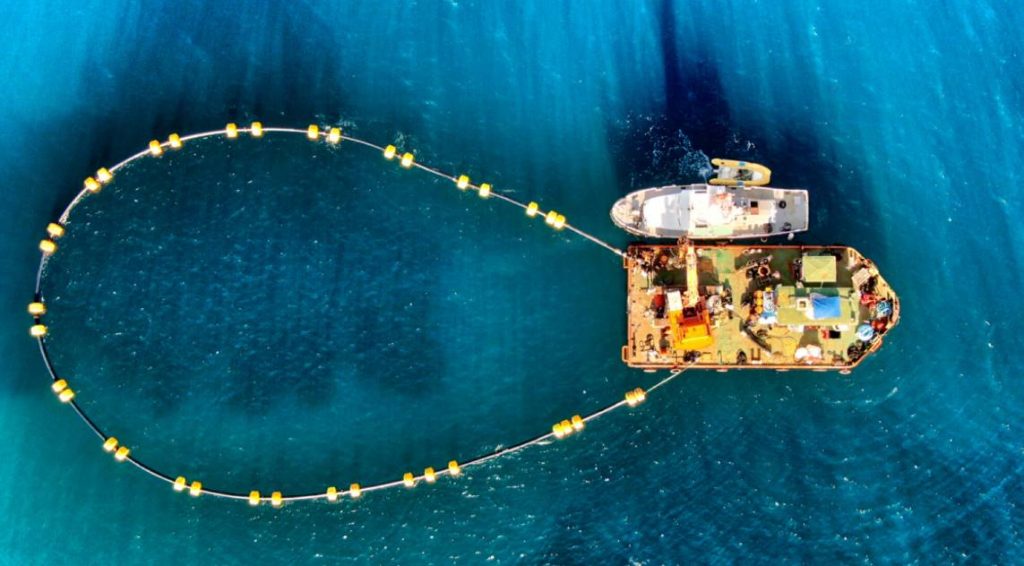
Based in the Netherlands, The Ocean Cleanup is arguably the most ambitious environmental non-profit organization. A decade ago, the then-18-year-old inventor Boyan Slat founded it with the purpose of extracting plastic pollution from the ocean. Since then, The Ocean Cleanup has been a crucial contributor to the marine conservation cause.
According to a Scientific Reports article (volume 8, Article number: 4666) titled Evidence that the Great Pacific Garbage Patch is rapidly accumulating plastic, a team of 16 contributing scientists surveyed the amount of plastic currently floating around our oceans. The article’s findings concluded: “Plastics were by far the most dominant type of marine litter found, representing more than 99.9% of the 1,136,145 pieces and 668 kg of floating debris collected by our trawls.”
On their website, The Ocean Cleanup describes the area they are tackling by saying, “The Great Pacific Garbage Patch is the largest accumulation of ocean plastic in the world and is located between Hawaii and California. Scientists of The Ocean Cleanup Foundation have conducted the most extensive analysis ever of this area.”
Some of the data included on The Ocean Cleanup’s official Instagram account (@theoceancleanup) shows the enormous size of the Great Pacific Garbage Patch, which many are comparing to the size of Texas.
On their website, The Ocean Cleanup describes their mission by saying, “Utilizing the ocean currents to our advantage, our passive drifting systems are estimated to clean up half the Great Pacific Garbage Patch in 5 years’ time.”
According to The Ocean Cleanup, a whopping 46% of the mass is made up of discarded fishing gear. No doubt, the fishing industry has some standards to reconsider.
The Ocean Cleanup’s ambitious project involves an enormous device called a “floater,” which, according to the website, is made out of a “hard-walled pipe made from high-density polyethylene (HDPE), an extremely durable and recyclable material.” The intention of this Floater is to “catch and concentrate plastic while also providing buoyancy to the whole system. The pipe is flexible enough to follow the waves and rigid enough to maintain its open U-shape. The floater will be around 1-2 km in length.”
A large screen is held underneath the floater to allow the currents to flow freely underneath it while allowing the garbage to collect above the surface.
The Floater will be carried out to sea by a large ship, as seen in this graphic representation provided by The Ocean Cleanup’s YouTube channel. The video describes the process of going out to collect the garbage.
Further into the video, we see a large anchor that allows the net underneath the floater to remain stable while collecting the debris found in the Great Pacific Garbage Patch.
What the team behind The Ocean Cleanup organization is hoping to accomplish is to improve our ecosystem, help relieve marine life from the garbage that is collecting in their habitat, and ultimately help remove the plastics that are slowly but surely creating a more toxic ocean.
The Ocean Cleanup is a Netherlands-based non-profit organization founded by Boyan Slat. Born in 1994, Slat is a Dutch entrepreneur and inventor with a special dedication to addressing environmental issues through his projects. This organization develops and scales cutting-edge technology with the intent to remove floating ocean plastic. The Ocean Buildup aims to remove 90% of marine debris by 2040.
It all started when a teenage Slat went scuba diving while on vacation in Greece and was shocked to see more plastic bags than fish in the sea. A simple question crossed his mind - “why can’t we clean this up?” Since then, he has started exploring the topic of ocean plastic pollution and possible technological solutions to it. Following the popularity of his TEDx video on the subject, Slat dropped out of his Aerospace Engineering degree and founded The Ocean Cleanup in 2013.
The initial scientific activities of the organization included testing concept iterations that allowed The Ocean Cleanup to achieve Proof of Technology for river interception and cleanup of the Great Pacific Garbage Patch in 2021. Today, this nonprofit organization is actively removing debris from the Great Pacific Garbage Patch and deploying interceptors in some of the most polluted rivers around the world to prevent plastic from reaching the ocean.
Throughout its activities, The Ocean Cleanup has contributed immensely to spreading awareness of marine plastic pollution. In addition to on-site action, its team has published scientific papers, tracing 80% of the world’s sea pollution to 1% of rivers. The organization has upgraded the scientific knowledge of the origin and types of plastic polluting the oceans. It has developed technological systems for tackling both ocean and river pollution.
The company’s ocean system removes marine debris with its floating barrier situated in oceanic gyres, funneling it into a collecting net or a wide-mouthed boat for direct processing. On the other hand, its river system employs the same concept of floating barriers, some of which are anchored to the river banks. With these barriers, the organization aims to protect 1,000 rivers.
However, since the inception of The Ocean Cleanup, scientists have questioned the efficiency and feasibility of the organization’s methods. For instance, some experts have expressed concern about the accidental harm the systems mentioned above could cause to marine life, such as sea turtles, marine mammals, and pelagic fishes. A potentially vulnerable part of ocean wildlife that can suffer consequences from the booms’ effects is the neuston, an underresearched group of organisms inhabiting the oceanic gyres.
This wildlife community includes microorganisms, plants, and animals such as sea snails, sail jellyfish, and the Portuguese man-o-war. Neuston organisms drift at the same level as plastic debris. Therefore, the systems designed for collecting debris can destroy the neuston population, leading to additional consequences for the ocean food chain.
Finally, The Ocean Cleanup’s mission seems a bit far-fetched in and of itself. Although a large part of ocean debris can be found floating on the surface, even more of it is way out of reach.